Sales growth loops are an important concept in business that plays a crucial role in growing companies and improving customer retention. Understanding how sales growth loops work and implementing them effectively can be a key contribution to business growth.
In this article, we will explore the definition of sales growth loops, their importance in business, how they work, different types of sales growth loops, and how to implement them in your own business. We will also discuss the potential challenges that may arise in implementing sales growth loops and provide strategies to overcome them.
| Key Element | Description | Tips for Optimization |
|---|---|---|
| Sales Growth Loops | A strategy leveraging customer revenue to hire sales reps, creating a self-sustaining growth cycle. | Ensure a strong understanding of revenue reinvestment for growth acceleration. |
| Key Components | Encompasses customer acquisition, revenue generation, and expanding the customer base via sales reps. | Focus on optimizing each component for better overall efficiency. |
| Importance in Business | Crucial for sustainable growth and enhancing customer retention. | Use satisfied customers to expand your customer base and maintain market competitiveness. |
| Implementation Strategies | Involves identifying target audiences, delivering exceptional experiences, and hiring motivated sales reps. | Iterate and refine based on customer feedback and data insights. |
| Challenges and Solutions | Includes limited acquisition channels and subpar customer experiences. | Employ a multi-channel approach and prioritize high-quality customer service. |
Defining sales growth loops
These loops are designed to create a virtuous cycle where each new customer brings in capital to acquire more customers. This results in exponential growth.
The basic concept behind sales growth loops is to leverage revenue generated from customers to hire sales representatives. These, in turn, bring in new customers through various mechanisms.
Compared to other types of loops, sales growth loops are ideal for products with a medium to high primary value promise friction - these are products whose primary value promise is more sophisticated and not as intuitive. To fully convey the value of the product, sales representatives are usually required.
The basic concept of sales growth loops
The basic concept of sales growth loops revolves around the idea that each new customer leads to more revenue. This revenue can then be used to hire distributors such as sales representatives and grow the business.
Key components of a sales growth loop
A sales growth loop typically consists of three key components.
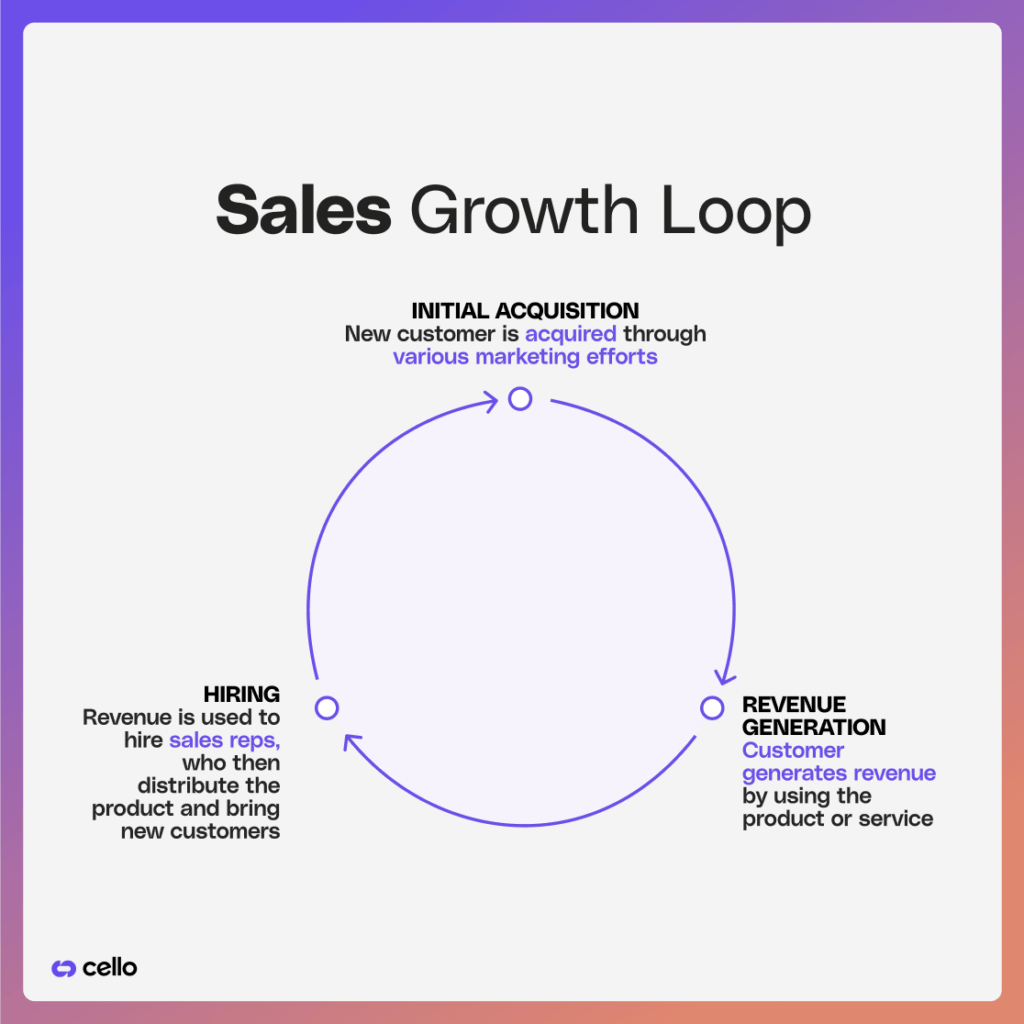
- Initial Acquisition: This is the first phase of the loop, where new customers are acquired through various marketing efforts such as advertising, social media campaigns, or search engine optimization.
- Revenue Generation: Once customers are acquired, it is crucial to provide them with an exceptional experience to retain and monetise them. This includes delivering on promises, providing quality products or services, and offering outstanding customer support.
- Hiring Sales Representatives: The revenue generated from customers can be used to employ sales representatives. These individuals can then distribute your product or service to new customers that may be interested in your value proposition, restarting the cycle.
Let's delve deeper into each of these components to understand how they contribute to the success of a sales growth loop.
1. Initial acquisition
The initial acquisition phase is where businesses put their marketing strategies into action to attract new customers. This can involve:
- Targeted advertising campaigns to reach the right audience.
- Engaging social media content that sparks interest.
- Search engine optimization techniques that improve visibility in online searches.
By effectively acquiring new customers, businesses lay the foundation for the growth loop to take shape.
2. Revenue generation
Once customers are acquired, the focus shifts to monetising and retaining them with an exceptional experience. This goes beyond simply delivering the product or service they purchased. It involves going the extra mile to exceed their expectations and create a lasting impression.
From prompt and friendly customer support to personalized interactions, businesses must prioritize customer satisfaction at every touchpoint. By consistently delivering on promises and building strong relationships, businesses increase the likelihood of customer retention, leading to recurring revenues.
3. Hiring sales representatives
Sales representatives are the lifeblood of a sales growth loop. When customers have a positive experience with a business, they stay with the service, leading to recurring revenues. This capital generated from customers can then be used by businesses to propel the sales growth loop, primarily by employing dedicated sales representatives.
These individuals ensure the value proposition of the business is shared with relevant audiences, leading to new customer acquisition and kickstarting a virtuous cycle. It is important to optimize sales representatives, including by improving productivity and reducing team turnover.
By understanding and optimizing each of these components, businesses can create a robust sales growth loop that fuels continuous growth. It's a strategic approach that leverages the power of satisfied customers to expand the customer base and drive exponential business growth.
The importance of sales growth loops in business
Sales growth loops play a vital role in driving sustainable growth and enhancing customer retention. Let's explore their importance in more detail. When we delve deeper into the realm of sales growth loops, we uncover a dynamic strategy that not only boosts revenue but also fosters long-term relationships with customers.
These loops operate on the premise of a continuous cycle where satisfied customers bring regular revenue, leading to the hiring of sales representatives. These, in turn, boost new customer acquisitions and further sales growth. This mechanism is a game-changer for businesses looking to thrive in competitive markets.
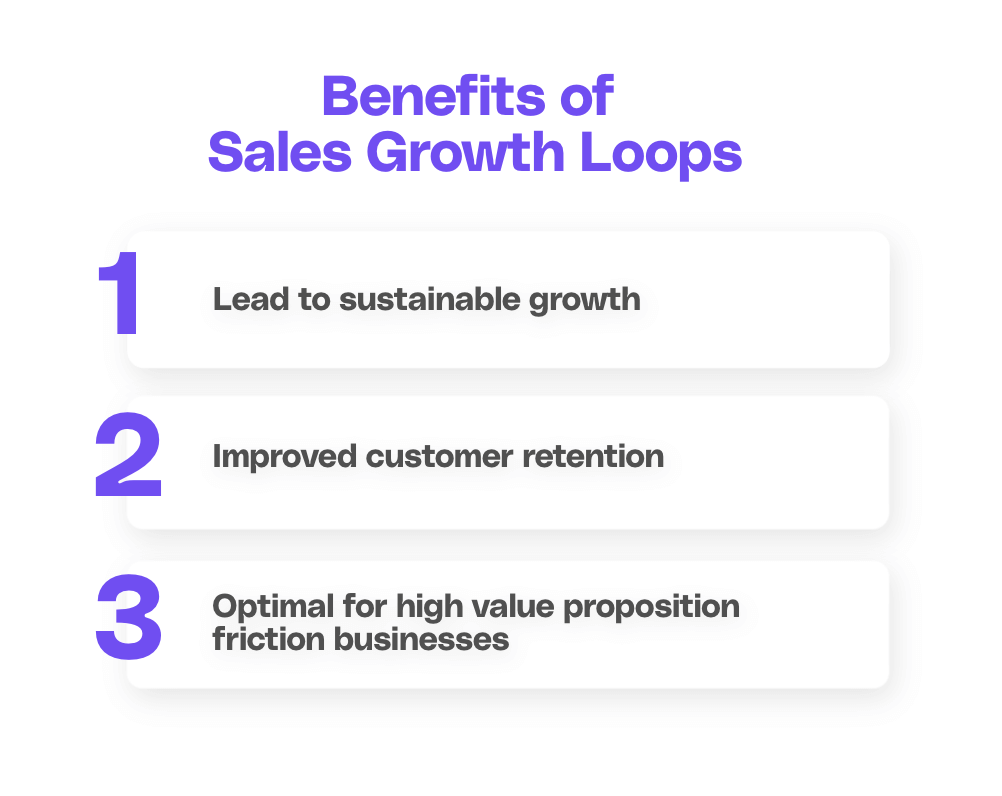
Driving sustainable growth
Traditional marketing and advertising approaches can be costly and may not always yield the desired results. Sales growth loops offer a more cost-effective way to drive sustainable growth.
By leveraging the revenue brought in by satisfied customers, businesses can tap into new markets and expand their customer base by hiring sales representatives.
Moreover, sales growth loops have the benefit that they rely on sales representatives' networks. These are often already quite extensive in their field. If fairly compensated, such loops may lead sales reps to prioritise your brand over others.
If other sales representatives hear about your program, this could also incentivise them to partner with your business. This accelerates the sales growth loop.
Enhancing customer retention
Customer retention is a critical factor in the success of any business. Sales growth loops focus on delivering exceptional customer experiences, which in turn fosters loyalty and increases the likelihood of customer retention.
When customers are satisfied and have positive experiences, they are more likely to become repeat buyers, increasing the revenues necessary to hire sales representatives.
Furthermore, the emphasis on customer retention within sales growth loops goes beyond just increasing sales numbers. It is about building lasting relationships with customers, understanding their needs, and adapting business strategies to meet those needs effectively.
By prioritizing customer satisfaction and retention, businesses can create a loyal customer base that serves as the foundation for sustainable growth and long-term success.
Value proposition friction
One particular advantage of sales growth loops is the the type of value proposition friction products it targets. There are three types of these.
| Friction Level | Description | Examples |
|---|---|---|
| Low | Products whose value is easily understood and where getting started is easy. Typically offered under a product-led model, where simple advertisements and user referrals are sufficient for growth. | Uber, Typeform |
| Medium | Products whose value is clear, but enhanced by human interaction. Getting started may take longer. Even with a product-led approach, human demonstrations can help in converting potential customers. | Fellow (offers freemium version and sales interaction) |
| High | Products that require human interaction for optimal distribution. These products are typically more complex to understand and implement, and benefit significantly from sales representatives guiding potential customers. | DropBox, HubSpot (both offer freemium models, but encourage booking demos) |
The benefit of sales growth loops is that they target medium to high value proposition friction products. While most growth loops are optimal for product-led businesses, sales growth loops allow even sales-led companies to leverage such mechanisms.
Moreover, sales growth loops have low barriers to entry. A company requires only one sales representative to get started.
How sales growth loops work
Now that we understand the importance of sales growth loops, let's dive deeper into how they work and their impact on business growth.
Sales growth loops are a fundamental concept in business strategy that focuses on creating a self-sustaining cycle of customer acquisition, satisfaction, and retention. By understanding the intricacies of these loops, businesses can leverage them to drive continuous growth and success.
The cycle of a sales growth loop
A typical sales growth loop follows a cyclical process.

- Acquire new customers: In the first stage, businesses focus on acquiring new customers through various marketing channels and strategies.
- Deliver exceptional experience: Once customers are acquired, the focus shifts to providing them with exceptional products, services, and customer support to ensure their satisfaction.
- Generate revenue: If your service has a product-led go-to-market model, the exceptional experience will increase the likelihood of monetising customers. For sales-led models, revenue is instantly generated, but great customer service will improve retention.
- Hire sales representatives: The capital generated from customers is reinvested into high-quality sales representatives. By referring your brand and seeking out new deals, these individuals ensure your value proposition reaches the right people, boosting your growth.
- Capture new customers: The sales representatives' efforts bring in new customers, initiating the cycle once again.
This cyclical nature of sales growth loops creates a continuous flow of new customers, referrals, and feedback, driving sustainable business growth over time.
Understanding the feedback mechanism
An integral part of sales growth loops is the feedback mechanism. As sales representatives refer others and new customers are acquired, businesses can gather valuable feedback to improve their products, services, or customer experience.
This feedback loop allows businesses to continuously optimize and enhance their offerings based on customer preferences and needs, leading to improved customer satisfaction and conversions.
By actively listening to customer feedback and incorporating it into their business strategies, companies can build stronger relationships with their customers and establish a reputation for excellence in their industry.
Understanding the primary value promise
As previously covered in our piece on incentivized viral loops, there are three types of value promise.

- Intrinsic: Intrinsic value promises occur when a party receives personal utility from a product, service, or action.
- Extrinsic: Extrinsic value promises are usually related to monetary gains of a certain party.
- Social: Social value promises normally relate to social recognition and status gains of a party.
When it comes to sales growth loops, there are three core parties.
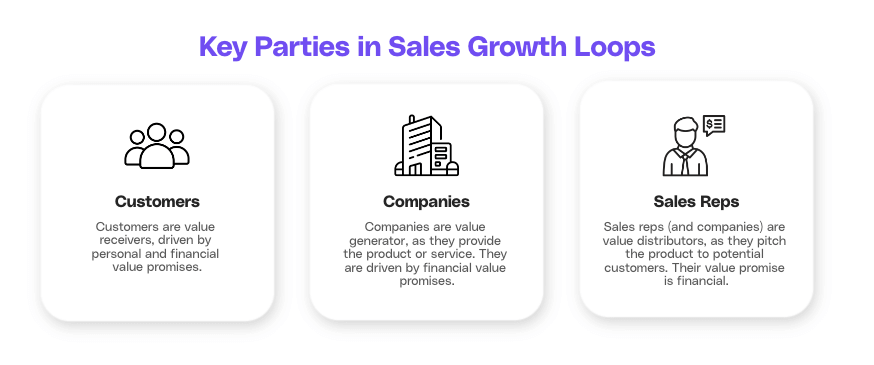
- Users and customers: this party is the value receiver, as they are ones using the product. In sales growth loops, they are driven by personal and financial value promises. On the one hand, they gain personal utility from using the product, as it likely simplifies their lives. On the other hand, the productivity gains lead to financial benefits, as opportunity costs are reduced and resources can be focused on other aspects.
- Companies: this party plays the role of the value generator, providing the product or service. As businesses are mostly profit-driven, the value promise is financial.
- Sales Representatives: this party, along with the company, plays the role of the value distributor by sharing the product with relevant prospective customers. As these individuals are normally compensated through commissions, their value promise is also financial.
Lead loop combination
One interesting dynamic for sales growth loops is that each single loop combines with another type of loop which is generating leads. How does this work?
- Each sales growth loop has the traditional stages of acquiring new customers, generating revenue, and hiring new sales representatives.
- There is a dynamic where new leads lead to more new leads which are then worked by the sales representatives. This accelerates the sales loop.
Outbound sales growth loop
In this case, the sales growth loop is combined with another sales growth loop. Each new lead that becomes a customer generates more money, which is then reinvested into hiring more sales reps.
The more of these additional combinations there are, the faster the growth loop. This tends to be the case for sales-led companies, as they require more human effort to convert leads.

Inbound sales growth loop
For inbound sales growth loops, sales reps work to attract new leads through content and advertisements generated by the company. Of the leads that view this content, a share become customers and share this content with their network.
This content then attracts new visitors to the website, which are converted by sales reps. Salesforce, for instance, combines a sales loop with a loop related to its content, leading to new leads and customers.
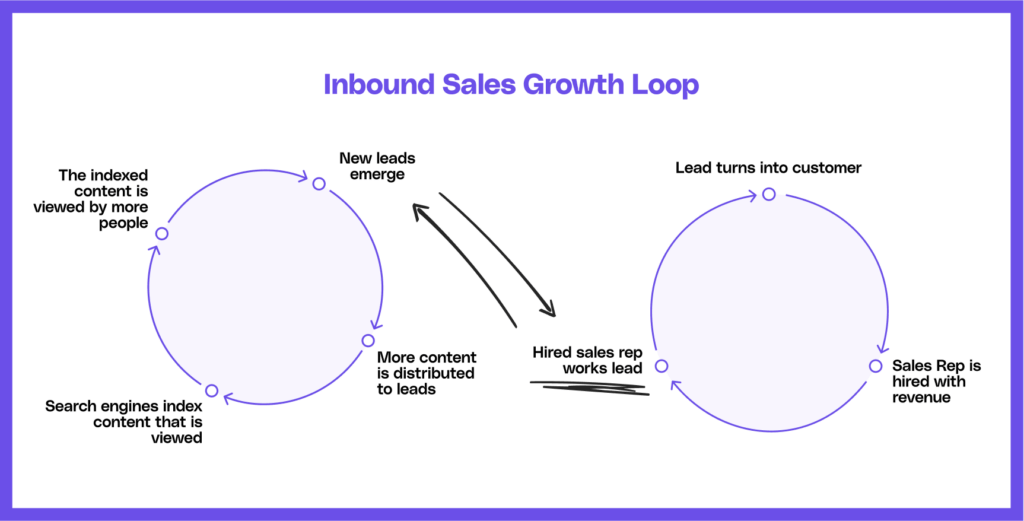
Product qualified leads
In this case, sales representatives work with leads to convert them. However, there is a clever integration of a viral loop within this system. Each client that invites users to use the product has a share of these which accept the invitation; these individuals become users and leads.
As they start using the product, they will likely invite more potential users, some of which again sign up, accelerating the cycle. An example of this is Slack: whenever someone gets invited to a workspace, they are likely to become clients and invite other new users, due to the benefits of network effects.
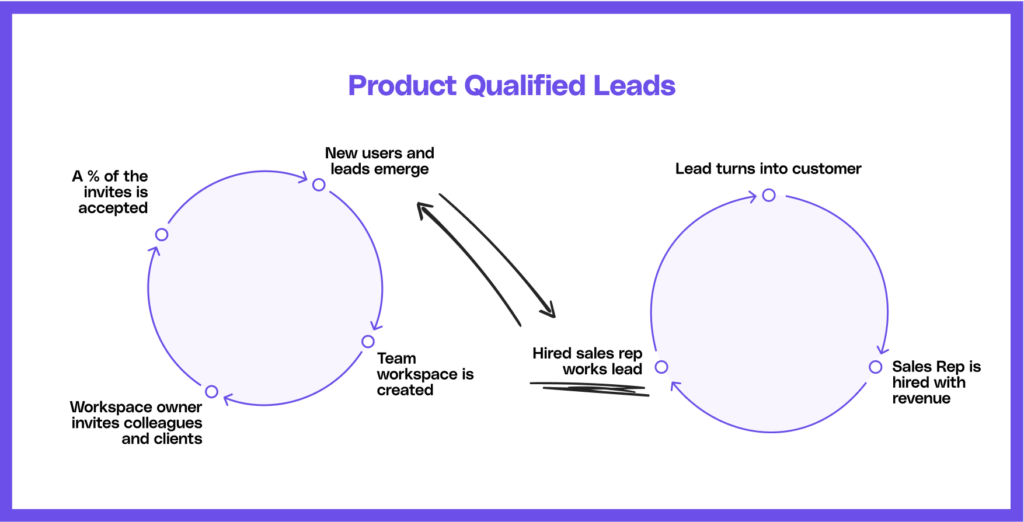
Implementing sales growth loops in your business
Now that we have explored the different aspects and types of sales growth loops, let's discuss how you can implement them in your own business.
Implementing sales growth loops can significantly impact the success and sustainability of your business. By creating a system that continuously drives sales through customer engagement and referrals, you can establish a strong foundation for growth and profitability.
Let's delve deeper into the steps and strategies involved in implementing sales growth loops.
Steps to create a sales growth loop
- Define Your Target Audience: Identify and understand the needs and preferences of your target audience.
- Create Outstanding Products or Services: Develop products or services that provide exceptional value and meet the needs of your target audience. Focus on delivering exceptional customer experiences.
- Monetise Your Clients: By providing outstanding customer support, exceeding expectations, and creating memorable interactions, you will likely convert and retain clients. This monetisation is a crucial step in sales growth loops.
- Hire Sales Representatives: Identify high-quality sales representatives through outbound and inbound methods. Design an attractive incentive scheme for them to refer your product. Start growing this way, and repeat the cycle.
Building a sales growth loop starts with understanding your customers and their journey with your brand. By defining your target audience and creating products or services that cater to their specific needs, you lay the groundwork for a successful loop.
Providing exceptional customer experiences not only fosters loyalty but also improves monetisation, enabling you to drive growth by hiring sales representatives.
Monitoring and optimizing your growth loop
Implementing sales growth loops requires continuous monitoring and optimization. Regularly review key metrics such as customer acquisition, retention rates, and sharing rates.
Use data analytics to gain insights into customer behavior and preferences. Based on this data, refine your strategies, improve customer experiences, and optimize your growth loop for maximum effectiveness.
By constantly evaluating and refining your sales growth loop, you can ensure that it remains relevant and impactful in driving business growth. Monitoring key performance indicators and leveraging data-driven insights will enable you to make informed decisions.
This enhances the overall effectiveness of your sales strategy. Remember, a well-executed sales growth loop can not only drive revenue but also cultivate long-lasting relationships with your customers and sales representatives.
Potential challenges and solutions in sales growth loops
While sales growth loops can be highly effective, there are potential challenges that businesses may face during implementation. Let's explore some common pitfalls and strategies to overcome them.
Implementing sales growth loops can be a transformative strategy for businesses looking to drive sustainable growth.
By creating a system where satisfied customers become brand advocates, companies can benefit from a continuous cycle of referrals and increased sales. However, despite their potential, growth loops are not without their challenges.
Common pitfalls in implementing sales growth loops
There are several common pitfalls.
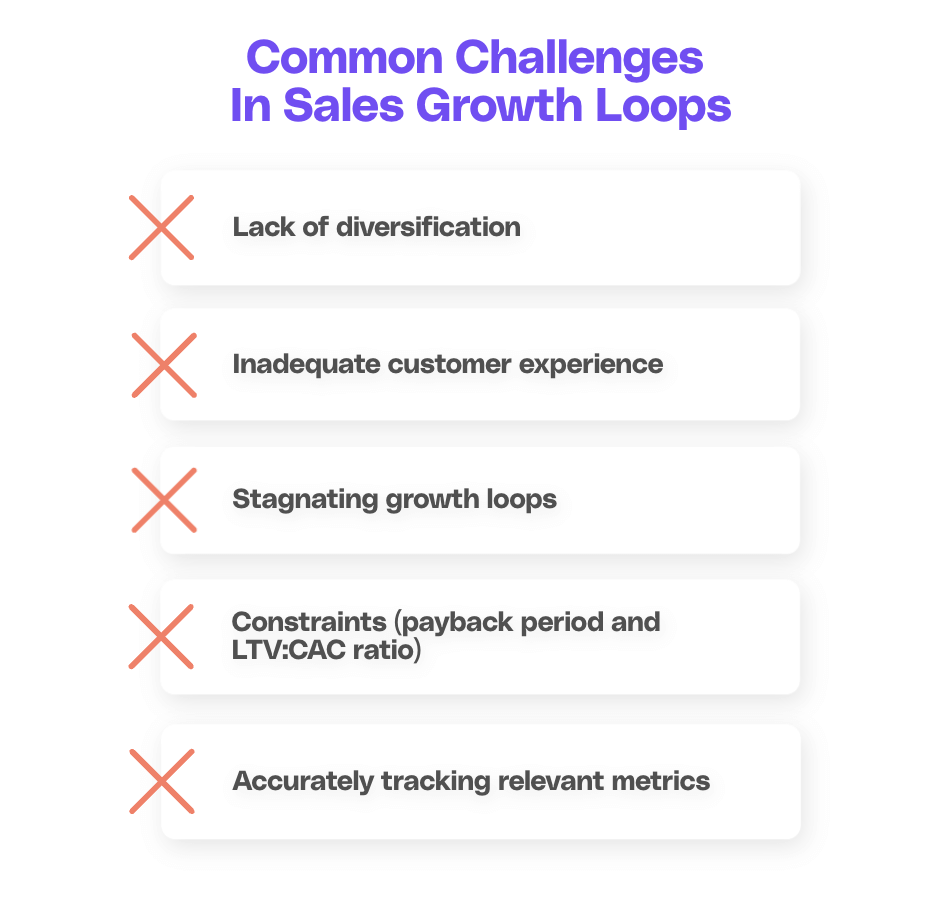
- Lack of diversification: Relying solely on a single marketing channel for customer acquisition can be an issue. Businesses should diversify their marketing efforts to reach a wider audience and maximize the chances of capturing new customers.
- Inadequate customer experience: Not providing a seamless and enjoyable customer experience can cause churn and hinder the growth loop. Businesses should prioritize enhancing their offerings and ensuring customer satisfaction to drive referrals.
- Stagnation: While sales growth loops are easy to get started, they become quite slow once they have reached a sustainable point. This is due to high people costs and longer cycle times.
- Constraints: Constraints of sales growth loops depend on the amount of capital available. If there is a lack of capital, there is a payback period of revenue generation before new sales representatives can be hired. If capital is abundant, the LTV:CAC ratio is a constraint.
- Metrics: A challenge businesses may encounter is accurately tracking and measuring the effectiveness of their sales growth loops.
Without proper analytics and key performance indicators in place, it can be difficult to assess the impact of different strategies and make data-driven decisions. This can lead to missed opportunities for optimization and growth.
Strategies to overcome growth loop challenges
To overcome growth loop challenges, businesses should continuously iterate and test their strategies. Experiment with different marketing channels, growth loops, referral incentives, and customer experience improvements.
Utilize customer feedback and data analytics to identify areas of improvement and make informed decisions. Additionally, fostering a culture of customer-centricity within the organization can lead to long-term success in implementing growth loops.
Furthermore, establishing clear goals and milestones for the growth loop implementation can help keep the team focused and motivated. By setting measurable objectives and regularly reviewing progress, businesses can stay on track and make adjustments as needed to optimize their sales growth strategy.
Conclusion
Sales growth loops are powerful systems that can fuel sustainable growth and enhance customer retention for businesses. By understanding the basic concept of sales growth loops, their importance in driving business growth, and how they work, businesses can harness the potential of customer referrals and create self-sustaining cycles of growth.
Implementing different types of growth loops and effectively monitoring and optimizing them can lead to significant business success. Despite potential challenges, businesses can overcome them through strategic approaches and customer-centricity. Embracing sales growth loops can unlock new opportunities and drive long-term success in today's competitive business landscape.
Transform your SaaS growth with Cello
Ready to turn your users into your most powerful growth engine? With Cello, you can effortlessly integrate a peer-to-peer referral program into your SaaS product, making user sharing seamless and rewarding. Experience the viral growth that comes from a delightful sharing experience and watch as your users propel your business forward. With minimal development time, immediate payback, and impressive conversion rates, Cello is the key to unlocking user-led growth. Don't just take our word for it; see how tl;dv achieved over 550 monthly referral signups in no time. Take the first step towards sustainable, exponential growth and book a demo to see Cello in action today.
Resources
Related Articles

4 Categories of Referral Programs for B2B SaaS
Learn how to get started with referral programs for B2B SaaS. Understand what type of referral ...
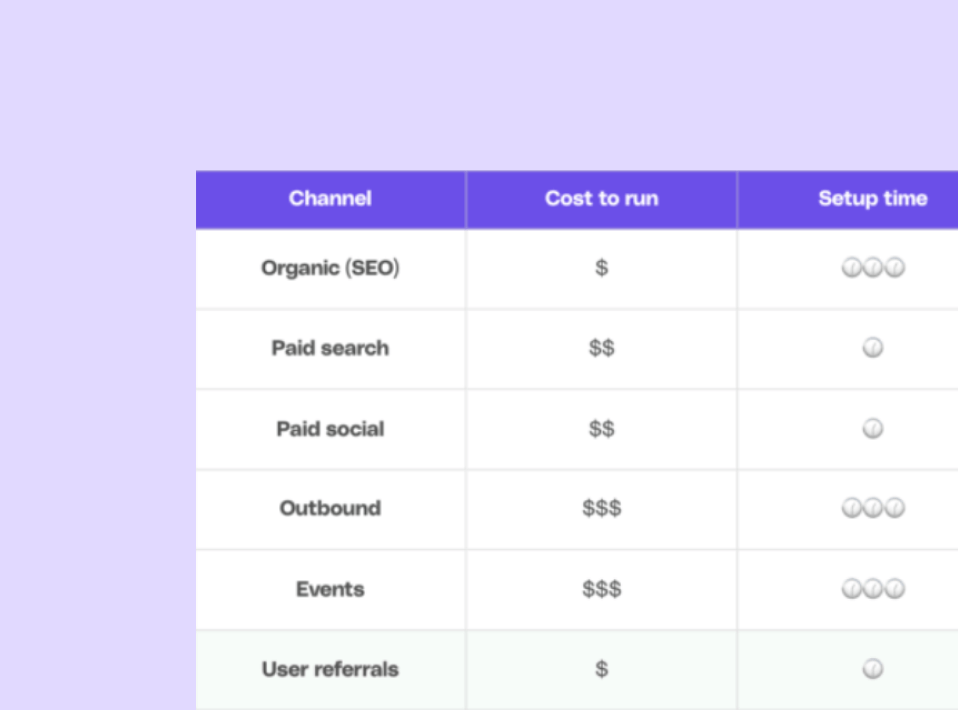
The Ultimate Guide to Referral Tracking
Discover everything you need to know about referral tracking with our ultimate guide! Learn how ...


